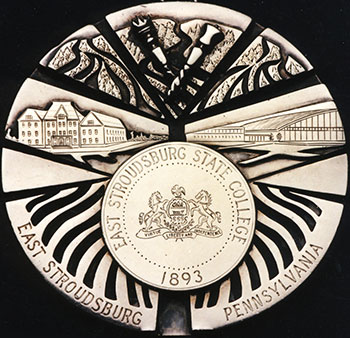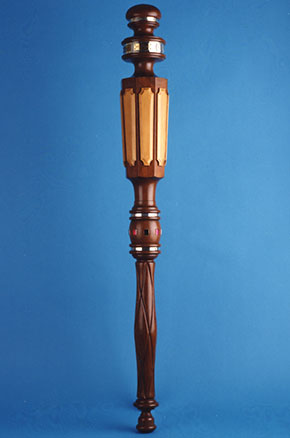
Inaugural Traditions
Academic Attire
The tradition of academic costume began in the medieval universities of Europe where gowns were everyday dress, providing for their wearers not only distinction but, quite possibly, warmth during long hours of study in poorly heated buildings.
Today, academic attire is seen on American campuses only at formal affairs such as commencement, Founder’s Day, dedications and inaugural ceremonies. In 1895, an Academic Costume Code was established, and has since been adopted by most of our colleges and universities. When the code is followed, one can identify the degree which the wearer holds, the university that awarded it, and the course of study it represents. The distinguishing features are the cut of the gown, the length and colors of the hood, and the color of the tassel on the cap.
The bachelor’s and master’s gowns are generally made of plain black cotton without trim, while the gown for the doctor’s degree is faced with black or colored velvet and has three bars of the same material across the sleeves. The bachelor’s gown has long open sleeves, the master’s gown has longer closed sleeves with arm slits at the elbow, and the doctor’s gown has bell-shaped sleeves extending to the wrist.
The hoods can be distinguished by both the length and color. The bachelor’s hood measures three feet, the master’s, three and one-half, and the doctor’s, four. The color of the velvet edging, which is wider for degrees higher than the bachelor’s, indicates the subject area to which the degree pertains. In addition to the colored edging, the hood shows in its lining the official color or colors of the institution which awarded the degree. The hood is worn such that a large part of the lining is visible.
The black mortarboard cap with tassel is worn with each type of gown. Those holding the doctorate wear gold tassels, while holders of the bachelor’s and master’s degrees generally wear a black tassel, although in recent years it has often been customary to wear the colored tassel symbolizing, like the hood, the subject area of the wearer’s degree.
In nearly every academic procession, a few costumes may be seen which do not conform to the standard patterns described above. Gold braid is frequently added to the gowns of academic administrators, and most faculties include several members who hold degrees from foreign universities, some of which prescribe very colorful attire.
The Presidential Medallion
 The medallion, or pectoral, has long been a symbol of the rights, authority, and power
of kings and queens. At the inception of the university around the year 1000 A.D.,
and to this day in many European institutions, the reigning monarch still functions
as the chancellor of the institution, its chief executive holding appointment as vice
chancellor. With the establishment of the academy independent of the crown, the royal
medallion has been retained as a symbol of the responsibilities and authority vested
in the office of the president of the university by the state.
The medallion, or pectoral, has long been a symbol of the rights, authority, and power
of kings and queens. At the inception of the university around the year 1000 A.D.,
and to this day in many European institutions, the reigning monarch still functions
as the chancellor of the institution, its chief executive holding appointment as vice
chancellor. With the establishment of the academy independent of the crown, the royal
medallion has been retained as a symbol of the responsibilities and authority vested
in the office of the president of the university by the state.
The East Stroudsburg University medallion was commissioned by the Student Activity Association in 1969, and first used by President Frank D. Sills at his inauguration. It was designed by Dr. Irene Mitchel, Professor of Art at East Stroudsburg University, and struck by Mr. Leslie Smith, an Allentown, Pa., craftsman. The chain of the pectoral was designed and crafted by Mr. Richard E. Phillips of East Stroudsburg, Pa.
The medallion has, on its obverse, the seal of the university. The seal is surrounded by the torch and the mace representing the light of learning and the authority of the university. These two symbols are superimposed on an abstract rendition of the Delaware Water Gap, so much a part of the geography of the region. On either side of the seal are representations of the original Stroud Hall (1893) and the current Koehler Fieldhouse (1967). Below the seal are the extended rays representing the 10 universities and 14 campuses of the Pennsylvania State System of Higher Education.
The University Mace
 The mace was originally a weapon of hand-to-hand combat in medieval times. With the
advent of firearms, such a weapon became archaic and was adopted to symbolize the
power and authority of kings and queens. Early in the history of the academy, the
mace was borrowed from royalty and utilized to symbolize the authority of the institution
given to it by the kings and queens and hence, the state, to grant baccalaureate and
advanced degrees so specified. The mace is used at all official university functions
of an academic nature.
The mace was originally a weapon of hand-to-hand combat in medieval times. With the
advent of firearms, such a weapon became archaic and was adopted to symbolize the
power and authority of kings and queens. Early in the history of the academy, the
mace was borrowed from royalty and utilized to symbolize the authority of the institution
given to it by the kings and queens and hence, the state, to grant baccalaureate and
advanced degrees so specified. The mace is used at all official university functions
of an academic nature.
The original East Stroudsburg University mace was commissioned by the ESU Alumni Association for the inauguration of President Frank D. Sills in 1969. It was designed and created by Mr. Richard E. Phillips, a local Pocono artisan. The redesigned mace, incorporating many features of the original mace and symbolizing the achievement of university status by East Stroudsburg State College, was commissioned by the University Commencement Committee in 1987. Mr. Phillips was again requested to modify the mace to reflect the transition from college to university, and Cherry Valley artisan Abby Porter completed the silver work. The current mace is made of cherry and is approximately 38 inches long. The mace has overlays made of hemlock, dating from 1893 from the original Stroud Hall. The black and red coloring represents the school colors.
The octagonal head of the mace represents the disciplines of the traditional academy, and four disciplines of contemporary higher education: Science, Arts, Humanities, and Philosophy. Surrounding the head are silver hands bearing the names and dates of the five precursor institutions. The handle is inset in silver with black onyx and red carnelian. The university seal crowns the mace.
Contact Us
Contact Information
- Campus Address
- Reibman Administration Building 204
- Phone:
- (570) 422-3545
- Fax:
- (570) 422-3478 (Fax)
- Title of Department Leader
- Executive Associate to President
- Name
- Marcy Cetnar
- E:
- president@esu.edu
- Phone:
- (570) 422-3546



